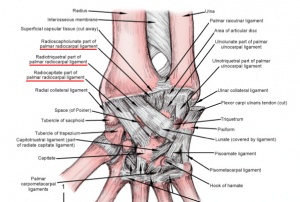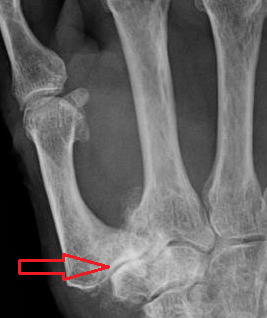Rhizarthrosis: Difference between revisions
(added video and text) |
(media) |
||
| Line 31: | Line 31: | ||
* Corticosteroid injections <ref>BMJ. [https://www.bmj.com/content/343/bmj.d7122.full Osteoarthritis of the base of the thumb]. Available from: https://www.bmj.com/content/343/bmj.d7122.full (last accessed 14.4.2019)</ref> | * Corticosteroid injections <ref>BMJ. [https://www.bmj.com/content/343/bmj.d7122.full Osteoarthritis of the base of the thumb]. Available from: https://www.bmj.com/content/343/bmj.d7122.full (last accessed 14.4.2019)</ref> | ||
== <sup>Physiotherapy</sup>[[File:Digit ROM Exercise Handout.jpg|frameless|200x200px]] == | |||
Techniques include | Techniques include | ||
* range-of-motion and stretching exercises to improve thumb motion. | * range-of-motion and stretching exercises to improve thumb motion. | ||
| Line 40: | Line 40: | ||
[https://www.jospt.org/doi/full/10.2519/jospt.2013.4524 The Effectiveness of a Manual Therapy and Exercise Protocol in Patients With Thumb Carpometacarpal Osteoarthritis: A Randomized Controlled Trial]. Available from: | [https://www.jospt.org/doi/full/10.2519/jospt.2013.4524 The Effectiveness of a Manual Therapy and Exercise Protocol in Patients With Thumb Carpometacarpal Osteoarthritis: A Randomized Controlled Trial]. Available from: | ||
☀https://www.jospt.org/doi/full/10.2519/jospt.2013.4524 (last accessed 14.4.2019) | ☀https://www.jospt.org/doi/full/10.2519/jospt.2013.4524 (last accessed 14.4.2019) | ||
</ref> | </ref> | ||
Revision as of 08:17, 14 April 2019
Introduction[edit | edit source]
Trapeziometacarpal (TMC) arthritis ( also known as Rhizarthrosis ) is arthritis of the first carpometacarpal (CMC) joint of the thumb. The CMC joint of the thumb (pollex), or TMC joint plays a critical role in the normal functioning of the thumb. It is the most important joint connecting the wrist to the metacarpus. Osteoarthritis of the TMC is a severely disabling condition; up to twenty times more common among elderly women than in average.[1]
Eitiology[edit | edit source]
Believed causes of TMC arthritis are: excessive repetitive use of the CMC joint of the thumb; a subluxation; a lesion of the ligaments or a fracture.
Laxity of the CMC joint is a key factor in causing TMC arthritis. The laxity, which can be hereditary, results in an increased risk for ligament injuries. These injuries are regarded as a primary stimulus in the development of arthritis. Laxity of the CMC joint also causes a hyperextension, which is another primary stimulus for the development of arthritis.[3]
Another common cause for TMC arthritis is weakness of the cross links of the fingers (ligg. oblique anterior). These ligaments are the most important stabilisers of the fingers. [4]
Symptoms[edit | edit source]
The first signs of arthritis in the thumb are
- pain, tenderness, and stiffness at the base of your thumb. This occurs with gripping, pinching, or clasping something between the thumb and index fingers or when a mild force, such as when you twist a key in a lock or turn a door handle. An ache after activity can also be a feature.
- Decreased strength and range of motion eg opening jars or doing up buttons may become difficult.
- Appearance. The joint may become swollen or develop a bony bump. The joint may appear squarish and enlarged.[5]
Diagnosis[edit | edit source]
- Noticeable lumps or swelling on the first CMC joint
- Thumb CMC grind test
- Plain radiographs showing degenerative changes (bone spurs, thinning of cartilage, loss of joint space)in affected joints are usually diagnostic.[6]
Treatment[edit | edit source]
Conservative measures are the first options for CMC arthritis and can ameliorate symptoms in most cases. These include
- Behaviour modification eg Try to avoid: clenching your hands when carrying things; repetitive movements that involve pinching or twisting.
- Physiotherapy
- Pain relief,
- Splinting, and
- Corticosteroid injections [7]
Physiotherapy [edit | edit source]
[edit | edit source]
Techniques include
- range-of-motion and stretching exercises to improve thumb motion.
- Advances to include strength exercises for the thumb and fingers.
- Dexterity and fine motor exercises for the hand and thumb. [9]
- Clinical trials have provided evidence that a combination of joint mobilization, neural mobilization, and exercise helps with CMC joint pain.[10]
- Application of therapeutic heat or cold
- Therapeutic US
- Splinting, designed to help reduce pain, prevent deformity, or prevent deformity from getting worse. Often only to wear at night, during flare ups and when doing heavy work with hand.[9]
injections
Injections of hyaluronic acid or cortisol are useful. A combination of ultrasound and injections is proved to be more effective than a therapy that is based on only one of these treatments.11
(c) Tractions[edit | edit source]
Tractions can be used in case of intra-articular fractures of the thumb metacarpal and fractures of the trapezium.
Already the day after the surgery, the revalidation can be started with tractions by a physiotherapist. Within three days, the patient should be self-capable of moving the thumb. Tractions have to be executed over a period of six weeks. This treatment is proved to diminish the pain and to improve the mobility of the joint. After eight to ten weeks, there shouldn’t be any pain left and the patient should be able to move his joint in the whole range of motion. No complications are known for this treatment. 12
Tractions are also a good prevention for collapse of the joint and subluxation of the thumb.
Immobilisation of the thumb would cause more pain and movement restriction than an immediate treatment. If the patient’s thumb is immobilised, there is a risk of varus deformity of the thumb. This is difficult to treat, because of the complete loss of abduction and extension.
Other treatments[edit | edit source]
(a) Medication[edit | edit source]
There are anti-inflammatory agents and injections based on cortisol, but these can be responsible for side effects like an increased sugar quality in blood, diminished endosperm synthesis and osteoporosis.6
(b) Brace[edit | edit source]
A brace can diminish stress on the joints, so pain and wear don’t occur, but it causes also an increased movement restriction.6
(c) Surgery[edit | edit source]
If the diagnosis of ‘rhizarthrosis’ is determined too late, none of the above treatments will be helpful. Because of severe pain and movement restriction, surgery could be inevitable. In this case, there will often be opted for a prosthesis.
But patients of younger age or with a history of earlier surgeries in the surrounding of this joint might be excluded from a prosthesis. In this case, a tendon transplantation could be an alternative.
If the surgery is finished successfully, the patient will be expected at the physiotherapist after three weeks of gypsum. Care must be taken to avoid complications like infections, dislocation of the prosthesis or nerve damage.1
References[edit | edit source]
1http://www.orthopedie-azdamiaan.be/Ned/aandoeningen/hand_pols/duimartrose.htm; evidence level F
2Dupeyron A, Ehrler S and Isner-Horobeti ME; Rhizarthrosis and orthotic treatment. Review of literature; Service de médecine physique et réadaptation, hôpital de Hautepierre, avenue Molière, 67098, Strasbourg, France ; 2001 ; evidence level D
3Mechael Schünke, Erik Schulte, Udo Shumacher, Markus Voll and Karl Werker; Prometheus: Algemene anatomie en bewegingsapparaat; Bohn Stafleu van Loghum; 2010; evidence level F
4 Jennifer Moriatis Wolf MD, Star Schreier MD, Scott Tomsick MD, Allison Williams PhD en Brian Petersen MD; Radiographic Laxity of the Trapeziometacarpal Joint Is Correlated With Generalized Joint Hypermobility; Department of Orthopaedic Surgery, University of Colorado-Denver, and the Division of Nursing/Research, Denver Veterans Administration Medical Center, Denver, CO, USA. [email protected]; 2011; evidence level C
5R. J. Poulter en T. R. C. Davis ; Management of hyperextension of the metacarpophalangeal joint in association with trapeziometacarpal joint osteoarthritis; of Trauma and Orthopaedics, Queens Medical Campus, Nottingham University Hospitals, Nottingham, UK; 2011; evidence level A
6http://users.telenet.be/zeldzame.ziekten/List.s/Corti(2).htm#Bijwerkingen; evidence level F
7Pedro A. Gondim Teixeira, Patrick Omoumi, Debra J. Trudell, Samuel R. Ward, Alain Blum en Donald L. Resnick; High-resolution ultrasound evaluation of the trapeziometacarpal joint with emphasis on the anterior oblique ligament (beak ligament); Service d'imagerie Guilloz, CHU Hôpital Central, 10 boulevard du Recteur Senn, appt. 220, 3eme étage, 54000, Nancy, France. [email protected]; 2010; evidence level E
8Physiotherapist Wim Van den Broeck; Graduated VUB (1986); Belgium; °1964; evidence level F
9 evidence level D
10http://www.kinos-team.be/therapieconcepten/manuele-therapie/neurodynamische-technieken/; evidence level F
11Di Sante L, Cacchio A, Scettri P, Paoloni M, Ioppolo F en Santilli V ; Ultrasound-guided procedure for the treatment of trapeziometacarpal osteoarthritis; Physical Medicine and Rehabilitation Unit, Azienda Policlinico Umberto I, Rome, Italy, [email protected].; 2011; evidence level F
12Gelberman RH, Vance RM en Zakaib GS; Fractures at the base of the thumb: treatment with oblique traction; 1979; evidence level D
- ↑ Wikipedia. CMC joint. Available from: https://en.wikipedia.org/wiki/Carpometacarpal_joint (last accessed 13.4.2019)
- ↑ Mayo clinic. Causes remedies for thumb arthritis. Available from: https://www.youtube.com/watch?v=iVbOPCu5Ius. (last accessed 13.4.2019)
- ↑ Wolf JM, Schreier S, Tomsick S, Williams A, Petersen B. Radiographic laxity of the trapeziometacarpal joint is correlated with generalized joint hypermobility. The Journal of hand surgery. 2011 Jul 1;36(7):1165-9. Available from: https://www.jhandsurg.org/article/S0363-5023(11)00353-4/abstract (last accessed 14.4.2019)
- ↑ A. Gondim Teixeira, Pedro & Omoumi, Patrick & J Trudell, Debra & Ward, Samuel & Blum, Alain & L Resnick, Donald. (2010). High-resolution ultrasound evaluation of the trapeziometacarpal joint with emphasis on the anterior oblique ligament (beak ligament). Skeletal radiology. 40. 897-904. 10.1007/s00256-010-1068-0. Available from: https://www.researchgate.net/publication/49647832_High-resolution_ultrasound_evaluation_of_the_trapeziometacarpal_joint_with_emphasis_on_the_anterior_oblique_ligament_beak_ligament
- ↑ Healthline. Basal joint arthritis. Available from: https://www.healthline.com/health/basal-joint-arthritis#symptoms (last accessed 14.4.2019)
- ↑ Mayo clinic. Thumb arthritis. Available from: https://www.mayoclinic.org/diseases-conditions/thumb-arthritis/diagnosis-treatment/drc-20378344 (last accessed 14.4.2019)
- ↑ BMJ. Osteoarthritis of the base of the thumb. Available from: https://www.bmj.com/content/343/bmj.d7122.full (last accessed 14.4.2019)
- ↑ Healing hands rehab. CMC arthritis. Available from: https://www.youtube.com/watch?v=wCIA1_tksjA&feature=youtu.be (last accessed 14.4.2019)
- ↑ 9.0 9.1 Central physiotherapy. Arthritis of the thumb. Available from: https://www.centralphysicaltherapy.com/Injuries-Conditions/Hand/Hand-Issues/Arthritis-of-the-Thumb/a~282/article.html (last accessed 14.4.2019)
- ↑ Jospt. The Effectiveness of a Manual Therapy and Exercise Protocol in Patients With Thumb Carpometacarpal Osteoarthritis: A Randomized Controlled Trial. Available from: ☀https://www.jospt.org/doi/full/10.2519/jospt.2013.4524 (last accessed 14.4.2019)







